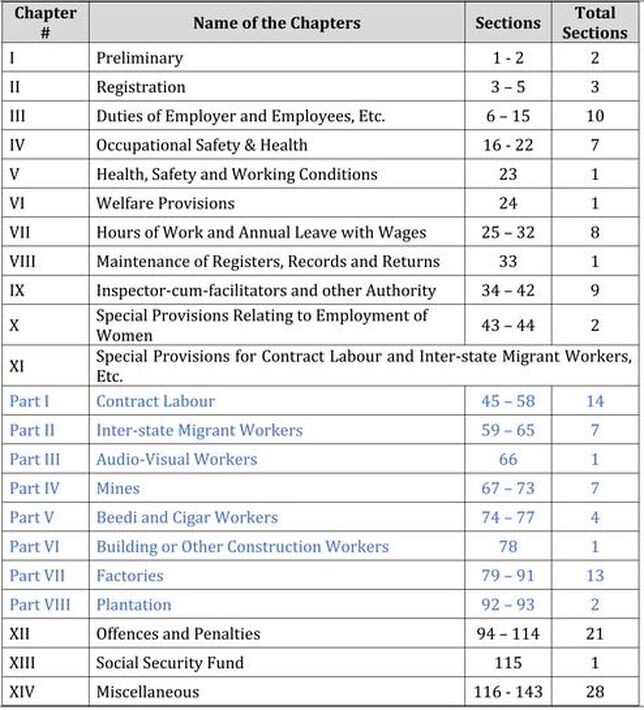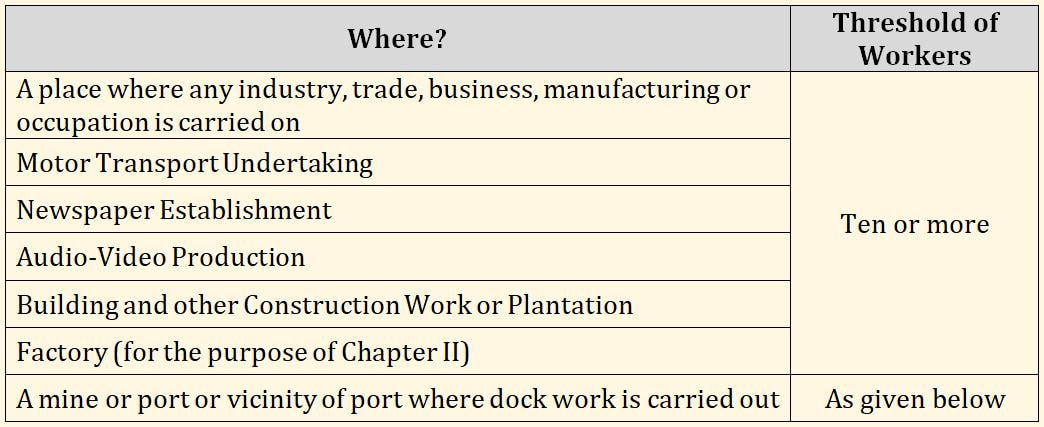|
Q1. Which of the existing labour laws the Occupational Safety, Health, and Working Conditions Code, 2020, shall repeal? The Occupational Safety, Health, and Working Conditions Code, 2020 consolidates the following 13 labour laws:
Q2. How the Occupational Safety, Health, and Working Conditions Code, 2020 has been organised? The code is organized into 14 chapters with a total of 143 sections and 3 schedules. Q3. Name the three schedules in the Occupational Safety, Health, and Working Conditions Code, 2020. *Section 2 (za): "hazardous process" means any process or activity in relation to an industry or plantation specified in the First Schedule where, unless special care is taken, raw materials used therein or the intermediate or finished products, bye-products, hazardous substances, wastes or effluents thereof or spraying of any pesticides, insecticides or chemicals used therein, as the case may be, would--
**Section 18 (2) (f): (2) In particular and without prejudice to the generality of the power to declare standards to be followed under sub-section (1), such standards shall relate to -- (f) matters specified in the Second Schedule to this Code. ***Section 12 (1): Where any worker in an establishment contracts any disease specified in the Third Schedule, the employer of the establishment shall send notice thereof to such authorities, and in such form and within such time, as may be prescribed by the appropriate Government. Q4. Does the Occupational Safety, Health, and Working Conditions Code, 2020 apply to Contract Labour employed through contractors in Central/State Government Offices? Yes. The code is not applicable for the offices of the Central/State Government. However, the code is applicable for contract labour employed through contractor in the offices of the Central/State Government, where, the Central/State Government is the Principal Employer. Q5. Who is the Principal Employer as per the Occupational Safety, Health, and Working Conditions Code, 2020? As per the Section 2 (zz) of the Code, where the Contract Labour is engaged, the Principal Employer is– Q6. Who is the Contractor as per the Occupational Safety, Health, and Working Conditions Code, 2020? As per the Section 2 (n) of the Code, in relation to an establishment, “contractor” means a person, who – “Undertakes to produce a given result for the establishment through contract labour or supplies contract labour for any work of the establishment as mere manpower.” Q7. What does the establishment mean by the Occupational Safety, Health and Working Conditions Code, 2020? As per the Section 2 (v) of the Code, the “establishment” means –
Q8. What is a “factory” according to the Occupational Safety, Health and Working Conditions Code, 2020? As per the Section 2 (w) of the Code, the “Factory” means any premises including the precincts thereof –
Q9. What is an “industrial premises” according to the Occupational Safety, Health and Working Conditions Code, 2020? As per the Section 2 (ZC) of the Code, an “industrial premises” means – Any place or premises (not being a private dwelling house), including the precincts thereof, in which or in any part of which any industry, trade, business, occupation or manufacturing is being ordinarily carried on with or without the aid of power and includes a godown attached thereto. Q10. What does “precinct” mean? As per the dictionary meaning, precinct means, “the area within the walls or perceived boundaries of a particular building or place.” In simple terms the precinct means a space enclosed by walls. The case law of K.V.V.Sharma AIR, 1953, Mad 269, stated precincts as “a space enclosed by walls or fences. A place solely used for some purpose other than the manufacturing process carried on in a factory or a workshop does not constitute a factory.”
0 Comments
Leave a Reply. |
Categories
All
HR Learning and Skill Building AcademyMHR LEARNING ACADEMYGet it on Google Play store
|
||||||
SITE MAP
SiteTRAININGJOB |
HR SERVICESOTHER SERVICESnIRATHANKA CITIZENS CONNECT |
NIRATHANKAPOSHOUR OTHER WEBSITESSubscribe |
MHR LEARNING ACADEMY
50,000 HR AND SOCIAL WORK PROFESSIONALS ARE CONNECTED THROUGH OUR NIRATHANKA HR GROUPS.
YOU CAN ALSO JOIN AND PARTICIPATE IN OUR GROUP DISCUSSIONS.
YOU CAN ALSO JOIN AND PARTICIPATE IN OUR GROUP DISCUSSIONS.
|
|









 RSS Feed
RSS Feed





